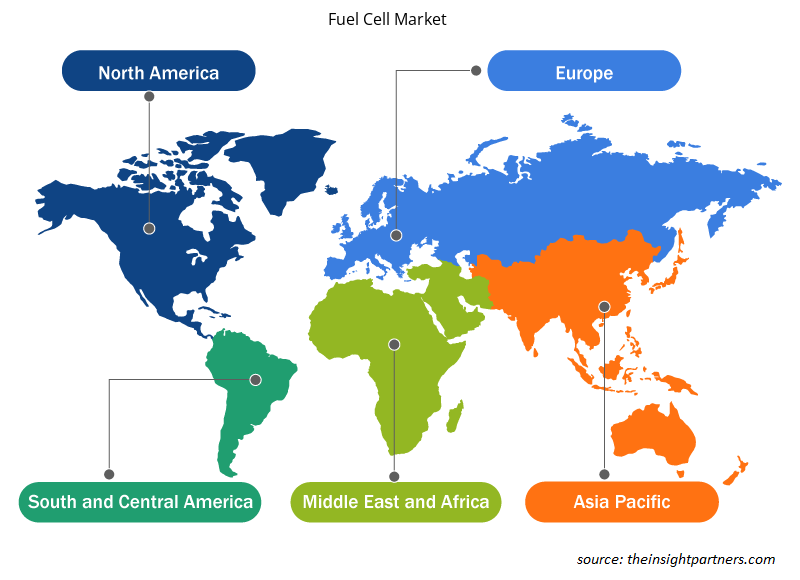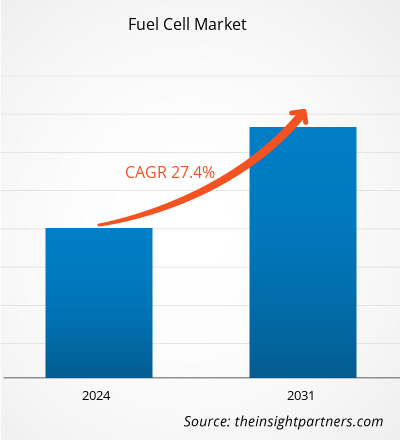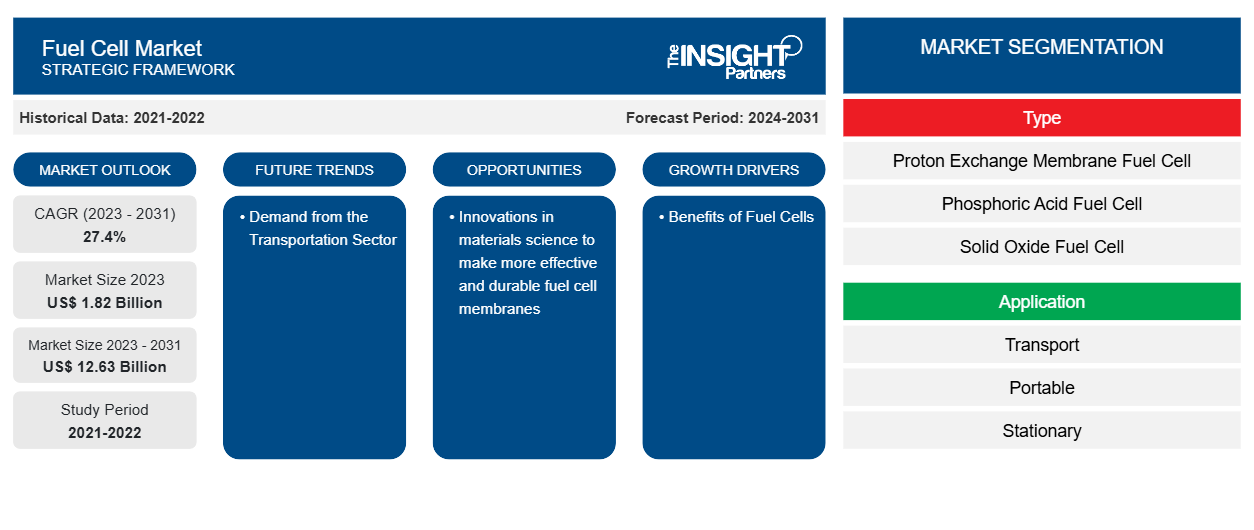Se prevé que el tamaño del mercado de las pilas de combustible alcance los 12.630 millones de dólares en 2031, frente a los 1.820 millones de dólares en 2023. Se espera que el mercado registre una CAGR del 27,4 % entre 2023 y 2031. Es probable que los beneficios de las pilas de combustible en comparación con las tecnologías tradicionales basadas en la combustión y la creciente demanda de fuentes de energía no convencionales sigan siendo clave para las tendencias del mercado de las pilas de combustible.CAGR of 27.4% in 2023–2031. The benefits of fuel cells over traditional combustion-based technologies and the growing demand for unconventional energy sources are likely to remain key to fuel cell market trends.
Análisis del mercado de las pilas de combustible
La creciente demanda de fuentes de energía no convencionales por parte de los consumidores es uno de los principales impulsores. Se prevé que la reducción del impacto ambiental impulse la demanda de tecnologías de pilas de combustible. Se espera que los gobiernos de todo el mundo complementen estos avances con apoyo de diversas formas, como la financiación de iniciativas de investigación y desarrollo y planes de financiación adecuados. Además, las iniciativas e inversiones gubernamentales para fomentar el mercado de vehículos eléctricos impulsan aún más el crecimiento del mercado.
Panorama del mercado de las pilas de combustible
Una pila de combustible genera electricidad de manera eficaz y limpia aprovechando la energía química del hidrógeno o de otros combustibles. Los únicos subproductos que se obtienen si el hidrógeno es el combustible son calor, agua y electricidad. La variedad de usos potenciales de las pilas de combustible las hace únicas: pueden alimentar sistemas tan grandes como centrales eléctricas y tan pequeños como ordenadores portátiles, utilizando una variedad de combustibles y materias primas.feedstocks.
Personalice este informe según sus necesidades
Obtendrá personalización en cualquier informe, sin cargo, incluidas partes de este informe o análisis a nivel de país, paquete de datos de Excel, así como también grandes ofertas y descuentos para empresas emergentes y universidades.
-
Obtenga las principales tendencias clave del mercado de este informe.Esta muestra GRATUITA incluirá análisis de datos, desde tendencias del mercado hasta estimaciones y pronósticos.
Factores impulsores y oportunidades del mercado de las pilas de combustible
Beneficios de las pilas de combustible para favorecer el mercado
Las pilas de combustible se pueden utilizar para alimentar una variedad de aplicaciones, incluido el transporte, los edificios industriales, comerciales y residenciales y el almacenamiento de energía de la red a largo plazo en sistemas reversibles. Las pilas de combustible tienen numerosas ventajas sobre las tecnologías tradicionales basadas en la combustión. Además, se utilizan en varias plantas de energía y vehículos. Puede funcionar con mayor eficiencia que los motores de combustión, convirtiendo la energía química del combustible directamente en energía eléctrica con eficiencias de más del 60%. En comparación con los motores de combustión , las pilas de combustible emiten menos o ninguna emisión. Las pilas de combustible de hidrógeno emiten solo agua, abordando desafíos climáticos críticos sin emisiones de dióxido de carbono. Tampoco hay contaminantes del aire que causen smog o problemas de salud en el punto de operación. Las pilas de combustible son silenciosas de operar porque tienen pocas partes móviles.
Demanda del sector transporte
El mercado de las pilas de combustible es una industria que se está expandiendo rápidamente y ofrece muchas oportunidades comerciales diferentes. La tecnología está en constante evolución y los nuevos diseños y materiales dan como resultado un mayor rendimiento y eficiencia. Como resultado, las pilas de combustible se están volviendo más atractivas para una mayor variedad de usos. El mercado de las pilas de combustible es uno de los más grandes en el sector del transporte. En comparación con los vehículos eléctricos de batería (BEV), los vehículos eléctricos de pila de combustible (FCEV) tienen una serie de beneficios, incluida una mayor autonomía y tiempos de reabastecimiento más rápidos. Se prevé que los vehículos de pila de combustible experimenten un rápido crecimiento en la participación de mercado a medida que el costo de los FCEV disminuya y la infraestructura del hidrógeno se expanda. Varias iniciativas del gobierno para impulsar el mercado de vehículos eléctricos en los próximos años pueden crear una gran oportunidad para el crecimiento del mercado de las pilas de combustible.BEVs), fuel cell FCEVs) have a number of benefits, including a greater range and quicker refueling times. Fuel cell vehicles are predicted to see rapid growth in market share as the cost of FCEVs decreases and the hydrogen infrastructure expands. Various initiatives by the government to bolster the electric vehicles market in the coming years can create a huge opportunity for the fuel cell market growth.
Análisis de segmentación del informe del mercado de pilas de combustible
Los segmentos clave que contribuyeron a la derivación del análisis del mercado de celdas de combustible son el tipo, la aplicación y el usuario final.
- Según el tipo, el mercado se segmenta en celdas de combustible de membrana de intercambio de protones (PEMFC), celdas de combustible de ácido fosfórico (PAFC), celdas de combustible de óxido sólido (SOFC) y otras. El segmento de celdas de combustible de membrana de intercambio de protones (PEMFC) tuvo una mayor participación de mercado en 2023.
- Por aplicación, el mercado se segmenta en transporte, portátiles y fijos. El segmento fijo tuvo una mayor participación de mercado en 2023.
- Por usuario final, el mercado está segmentado en vehículos de pila de combustible, servicios públicos, defensa y otros. El segmento de servicios públicos tuvo una mayor participación de mercado en 2023.
Análisis de la cuota de mercado de las pilas de combustible por geografía
El alcance geográfico del informe del mercado de pilas de combustible se divide principalmente en cinco regiones: América del Norte, Asia Pacífico, Europa, Medio Oriente y África, y América del Sur/América del Sur y Central.
En términos de ingresos, Asia Pacífico representó la mayor participación en el mercado de celdas de combustible en 2023. Fabricantes de automóviles como Yamaha, Toyota y otros están tomando medidas para fomentar las tecnologías de celdas de combustible, lo que está llevando al crecimiento del mercado de celdas de combustible de Asia Pacífico. Por ejemplo, en enero de 2023, en línea con su misión de "Producir felicidad para todos", que busca contribuir a establecer una sociedad sostenible "a prueba de futuro" que esté en armonía con la naturaleza, Toyota ha estado desarrollando tecnologías ecológicas y limpias que promueven la sostenibilidad en todas las regiones. Al ser pioneros en tecnologías de vehículos eléctricos y otros vehículos ecológicos, la empresa se esfuerza por ofrecer una variedad de vehículos eléctricos y de combustible alternativo para minimizar las emisiones de CO2 teniendo en cuenta la generación de energía, la preparación de la infraestructura y la adopción por parte de los consumidores de cada país/región. Además, a nivel mundial, Toyota se ha comprometido con la neutralidad de carbono para 2050 y tiene como objetivo lograr el carbono neto cero en las operaciones de fabricación para 2035.
Perspectivas regionales del mercado de pilas de combustible
Los analistas de Insight Partners explicaron en detalle las tendencias y los factores regionales que influyen en el mercado de pilas de combustible durante el período de pronóstico. En esta sección también se analizan los segmentos y la geografía del mercado de pilas de combustible en América del Norte, Europa, Asia Pacífico, Oriente Medio y África, y América del Sur y Central.

- Obtenga datos regionales específicos para el mercado de pilas de combustible
Alcance del informe sobre el mercado de pilas de combustible
| Atributo del informe | Detalles |
|---|---|
| Tamaño del mercado en 2023 | 1.820 millones de dólares estadounidenses |
| Tamaño del mercado en 2031 | US$ 12,63 mil millones |
| CAGR global (2023 - 2031) | 27,4% |
| Datos históricos | 2021-2022 |
| Período de pronóstico | 2024-2031 |
| Segmentos cubiertos |
Por tipo
|
| Regiones y países cubiertos |
América del norte
|
| Líderes del mercado y perfiles de empresas clave |
|
Densidad de actores del mercado de pilas de combustible: comprensión de su impacto en la dinámica empresarial
El mercado de las pilas de combustible está creciendo rápidamente, impulsado por la creciente demanda de los usuarios finales debido a factores como la evolución de las preferencias de los consumidores, los avances tecnológicos y una mayor conciencia de los beneficios del producto. A medida que aumenta la demanda, las empresas amplían sus ofertas, innovan para satisfacer las necesidades de los consumidores y aprovechan las tendencias emergentes, lo que impulsa aún más el crecimiento del mercado.
La densidad de actores del mercado se refiere a la distribución de las empresas o firmas que operan dentro de un mercado o industria en particular. Indica cuántos competidores (actores del mercado) están presentes en un espacio de mercado determinado en relación con su tamaño o valor total de mercado.
Las principales empresas que operan en el mercado de pilas de combustible son:
- Fabricante: Cummins Inc.
- Compañía energética Fuel Cell, Inc.
- Enchufe Power Inc.
- Energía floreciente
- Sistemas de energía Ballard
- SFC Energía AG
Descargo de responsabilidad : Las empresas enumeradas anteriormente no están clasificadas en ningún orden particular.

- Obtenga una descripción general de los principales actores clave del mercado de celdas de combustible
Noticias y desarrollos recientes del mercado de pilas de combustible
El mercado de las pilas de combustible se evalúa mediante la recopilación de datos cualitativos y cuantitativos a partir de una investigación primaria y secundaria, que incluye publicaciones corporativas importantes, datos de asociaciones y bases de datos. A continuación, se incluye una lista de los avances del mercado:
- En septiembre de 2023, en un paso significativo hacia la movilidad ecológica, el Ministro de Petróleo y Gas Natural y de Vivienda y Asuntos Urbanos de la India inauguró el primer autobús ecológico con pila de combustible de hidrógeno en Kartavya Path, en Delhi. (Fuente: Ministerio de Petróleo y Gas Natural, comunicado de prensa, 2023)
- En marzo de 2024, Hyzon (NASDAQ: HYZN), un desarrollador líder de tecnología de celdas de combustible de hidrógeno con sede en EE. UU. y proveedor global de vehículos eléctricos de celdas de combustible (FCEV) de servicio pesado con cero emisiones, lanzó su sistema de celdas de combustible de 200 kW de una sola pila y su tren motriz en un vehículo en una ceremonia a la que asistieron funcionarios gubernamentales, operadores de flotas de servicio pesado y empleados y ejecutivos de la empresa. (Fuente: PR Newswire, comunicado de prensa, 2024)
- En enero de 2024, la ISRO probó con éxito un sistema de energía basado en celdas de combustible de membrana de electrolito polimérico (FCPS) de 100 W en su plataforma orbital POEM3, lanzada a bordo del PSLV-C58 el 1 de enero de 2024. El objetivo del experimento era evaluar el funcionamiento de las celdas de combustible de membrana de electrolito polimérico en el espacio y recopilar datos para facilitar el diseño de sistemas para futuras misiones. Durante la prueba de corta duración a bordo del POEM, se generaron 180 W de energía a partir de gases de hidrógeno y oxígeno almacenados a bordo en recipientes de alta presión. Esto proporcionó una gran cantidad de datos sobre el rendimiento de varios sistemas estáticos y dinámicos que formaban parte del sistema de energía y la física en juego. (Fuente: ISRO, comunicado de prensa, 2024)
Informe sobre el mercado de pilas de combustible: cobertura y resultados
El informe “Tamaño y pronóstico del mercado de pilas de combustible (2021-2031)” proporciona un análisis detallado del mercado que cubre las siguientes áreas:
- Tamaño del mercado y pronóstico a nivel global, regional y nacional para todos los segmentos clave del mercado cubiertos bajo el alcance
- Dinámica del mercado, como impulsores, restricciones y oportunidades clave
- Principales tendencias futuras
- Análisis detallado de las cinco fuerzas de Porter y PEST y FODA
- Análisis del mercado global y regional que cubre las tendencias clave del mercado, los principales actores, las regulaciones y los desarrollos recientes del mercado.
- Análisis del panorama de la industria y de la competencia que abarca la concentración del mercado, el análisis de mapas de calor, los actores destacados y los desarrollos recientes
- Perfiles detallados de empresas
- Análisis histórico (2 años), año base, pronóstico (7 años) con CAGR
- Análisis PEST y FODA
- Tamaño del mercado, valor/volumen: global, regional y nacional
- Industria y panorama competitivo
- Conjunto de datos de Excel
Informes recientes
Informes relacionados
Testimonios
Razón para comprar
- Toma de decisiones informada
- Comprensión de la dinámica del mercado
- Análisis competitivo
- Información sobre clientes
- Pronósticos del mercado
- Mitigación de riesgos
- Planificación estratégica
- Justificación de la inversión
- Identificación de mercados emergentes
- Mejora de las estrategias de marketing
- Impulso de la eficiencia operativa
- Alineación con las tendencias regulatorias























 Obtenga una muestra gratuita para - Mercado de pilas de combustible
Obtenga una muestra gratuita para - Mercado de pilas de combustible